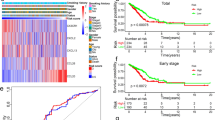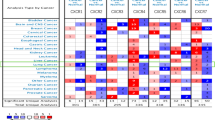Abstract
Chemokines play a critical role in lung cancer progression and metastasis. In non-small cell lung cancer, the determination of dominant angiogenic CXCL-type chemokines may increase the efficacy of targeted therapy and modulate the prognosis of lung cancer. Also, chemokine and chemokine receptors shape the immune response in the cross-talk between both cancer cells and immune cells in the tumor microenvironment. In this computational evaluation study based on databases containing mostly RNA-seq analyses, it is aimed to determine the dominant angiogenic CXCL-type chemokines with the highest expression in lung adenocarcinoma tissues and particularly in non-small cell lung cancer cells. CXCL1, CXCL5, CXCL7, and CXCL8, which can potentially be co-regulated and associated with poor survival, and phagocyte infiltration including neutrophils and macrophages are predominantly identified in non-small cell lung cancer. Moreover, the receptors of these chemokines, CXCR1 (binding CXCL8) and CXCR2 (binding CXCL1, 5, 7, 8), are positively correlated with the infiltration of neutrophils and macrophages. With the discovery of the common regulatory mechanisms of these angiogenic chemokines and validation studies in clinical examples, the chemokine panels specific to non-small cell lung cancer will become clear and have a decisive role in the prognosis of the disease.








Similar content being viewed by others
References
Mollica Poeta V, Massara M, Capucetti A, Bonecchi R. Chemokines and chemokine receptors: new targets for cancer immunotherapy. Front Immunol. 2019;10:379. https://doi.org/10.3389/fimmu.2019.00379.
Strieter RM, Belperio JA, Burdick MD, Sharma S, Dubinett SM, Keane MP. CXC chemokines: angiogenesis, immunoangiostasis, and metastases in lung cancer. Ann N Y Acad Sci. 2004;1028:351–60. https://doi.org/10.1196/annals.1322.041.
Yuan M, Zhu H, Xu J, Zheng Y, Cao X, Liu Q. Tumor-derived CXCL1 promotes lung cancer growth via recruitment of tumor-associated neutrophils. J Immunol Res. 2016;2016:6530410. https://doi.org/10.1155/2016/6530410.
Wu K, Yu S, Liu Q, Bai X, Zheng X, Wu K. The clinical significance of CXCL5 in non-small cell lung cancer. Onco Targets Ther. 2017;10:5561–73. https://doi.org/10.2147/OTT.S148772.
Li J, Tang Z, Wang H, Wu W, Zhou F, Ke H, et al. CXCL6 promotes non-small cell lung cancer cell survival and metastasis via down-regulation of miR-515-5p. Biomed Pharmacother. 2018;97:1182–8. https://doi.org/10.1016/j.biopha.2017.11.004.
Spaks A, Jaunalksne I, Spaka I, Chudasama D, Pirtnieks A, Krievins D. Diagnostic value of circulating CXC chemokines in non-small cell lung cancer. Anticancer Res. 2015;35(12):6979–83.
De Filippo K, Henderson RB, Laschinger M, Hogg N. Neutrophil chemokines KC and macrophage-inflammatory protein-2 are newly synthesized by tissue macrophages using distinct TLR signaling pathways. J Immunol. 2008;180(6):4308–15. https://doi.org/10.4049/jimmunol.180.6.4308.
Lu J, Xu W, Qian J, Wang S, Zhang B, Zhang L, et al. Transcriptome profiling analysis reveals that CXCL2 is involved in anlotinib resistance in human lung cancer cells. BMC Med Genomics. 2019;12(Suppl 2):38. https://doi.org/10.1186/s12920-019-0482-y.
Scapini P, Morini M, Tecchio C, Minghelli S, Di Carlo E, Tanghetti E, et al. CXCL1/macrophage inflammatory protein-2-induced angiogenesis in vivo is mediated by neutrophil-derived vascular endothelial growth factor-A. J Immunol. 2004;172(8):5034–40. https://doi.org/10.4049/jimmunol.172.8.5034.
Zhang W, Wang H, Sun M, Deng X, Wu X, Ma Y, et al. CXCL5/CXCR2 axis in tumor microenvironment as potential diagnostic biomarker and therapeutic target. Cancer Commun. 2020;40(2–3):69–80. https://doi.org/10.1002/cac2.12010.
Arenberg DA, Keane MP, DiGiovine B, Kunkel SL, Morris SB, Xue YY, et al. Epithelial-neutrophil activating peptide (ENA-78) is an important angiogenic factor in non-small cell lung cancer. J Clin Invest. 1998;102(3):465–72. https://doi.org/10.1172/JCI3145.
Grepin R, Guyot M, Giuliano S, Boncompagni M, Ambrosetti D, Chamorey E, et al. The CXCL7/CXCR1/2 axis is a key driver in the growth of clear cell renal cell carcinoma. Cancer Res. 2014;74(3):873–83. https://doi.org/10.1158/0008-5472.CAN-13-1267.
Masuya D, Huang C, Liu D, Kameyama K, Hayashi E, Yamauchi A, et al. The intratumoral expression of vascular endothelial growth factor and interleukin-8 associated with angiogenesis in nonsmall cell lung carcinoma patients. Cancer. 2001;92(10):2628–38. https://doi.org/10.1002/1097-0142(20011115)92:10%3c2628::aid-cncr1616%3e3.0.co;2-f.
Hol J, Wilhelmsen L, Haraldsen G. The murine IL-8 homologues KC, MIP-2, and LIX are found in endothelial cytoplasmic granules but not in Weibel-Palade bodies. J Leukoc Biol. 2010;87(3):501–8. https://doi.org/10.1189/jlb.0809532.
Azenshtein E, Meshel T, Shina S, Barak N, Keydar I, Ben-Baruch A. The angiogenic factors CXCL8 and VEGF in breast cancer: regulation by an array of pro-malignancy factors. Cancer Lett. 2005;217(1):73–86. https://doi.org/10.1016/j.canlet.2004.05.024.
Kim SJ, Uehara H, Karashima T, McCarty M, Shih N, Fidler IJ. Expression of interleukin-8 correlates with angiogenesis, tumorigenicity, and metastasis of human prostate cancer cells implanted orthotopically in nude mice. Neoplasia. 2001;3(1):33–42. https://doi.org/10.1038/sj.neo.7900124.
Liu Q, Li A, Tian Y, Wu JD, Liu Y, Li T, et al. The CXCL8-CXCR1/2 pathways in cancer. Cytokine Growth Factor Rev. 2016;31:61–71. https://doi.org/10.1016/j.cytogfr.2016.08.002.
Gyorffy B, Lanczky A, Eklund AC, Denkert C, Budczies J, Li Q, et al. An online survival analysis tool to rapidly assess the effect of 22,277 genes on breast cancer prognosis using microarray data of 1,809 patients. Breast Cancer Res Treat. 2010;123(3):725–31. https://doi.org/10.1007/s10549-009-0674-9.
Tang Z, Li C, Kang B, Gao G, Li C, Zhang Z. GEPIA: a web server for cancer and normal gene expression profiling and interactive analyses. Nucleic Acids Res. 2017;45(W1):W98–102. https://doi.org/10.1093/nar/gkx247.
Consortium GT. Human genomics. The genotype-tissue expression (GTEx) pilot analysis: multitissue gene regulation in humans. Science. 2015;348(6235):648–60. https://doi.org/10.1126/science.1262110.
Consortium GT. The genotype-tissue expression (GTEx) project. Nat Genet. 2013;45(6):580–5. https://doi.org/10.1038/ng.2653.
Barretina J, Caponigro G, Stransky N, Venkatesan K, Margolin AA, Kim S, et al. The cancer cell line encyclopedia enables predictive modelling of anticancer drug sensitivity. Nature. 2012;483(7391):603–7. https://doi.org/10.1038/nature11003.
Nagarsheth N, Wicha MS, Zou W. Chemokines in the cancer microenvironment and their relevance in cancer immunotherapy. Nat Rev Immunol. 2017;17(9):559–72. https://doi.org/10.1038/nri.2017.49.
Keeley EC, Mehrad B, Strieter RM. Chemokines as mediators of tumor angiogenesis and neovascularization. Exp Cell Res. 2011;317(5):685–90. https://doi.org/10.1016/j.yexcr.2010.10.020.
Gu LP, Yao YX, Chen ZW. An inter-correlation among chemokine (C-X-C motif) ligand (CXCL) 1, CXCL2 and CXCL8, and their diversified potential as biomarkers for tumor features and survival profiles in non-small cell lung cancer patients. Transl Cancer Res. 2021;10(2):748. https://doi.org/10.21037/tcr-20-2539.
Liu Q, Li A, Yu S, Qin S, Han N, Pestell RG, et al. DACH1 antagonizes CXCL8 to repress tumorigenesis of lung adenocarcinoma and improve prognosis. J Hematol Oncol. 2018;11(1):53. https://doi.org/10.1186/s13045-018-0597-1.
Zlotnik A, Yoshie O. The chemokine superfamily revisited. Immunity. 2012;36(5):705–16. https://doi.org/10.1016/j.immuni.2012.05.008.
Herjan T, Yao P, Qian W, Li X, Liu C, Bulek K, et al. HuR is required for IL-17-induced Act1-mediated CXCL1 and CXCL5 mRNA stabilization. J Immunol. 2013;191(2):640–9. https://doi.org/10.4049/jimmunol.1203315.
Katanov C, Lerrer S, Liubomirski Y, Leider-Trejo L, Meshel T, Bar J, et al. Regulation of the inflammatory profile of stromal cells in human breast cancer: prominent roles for TNF-alpha and the NF-kappaB pathway. Stem Cell Res Ther. 2015;6:87. https://doi.org/10.1186/s13287-015-0080-7.
Chen X, Jin R, Chen R, Huang Z. Complementary action of CXCL1 and CXCL8 in pathogenesis of gastric carcinoma. Int J Clin Exp Pathol. 2018;11(2):1036–45.
Wang L, Shi L, Gu J, Zhan C, Xi J, Ding J, et al. CXCL5 regulation of proliferation and migration in human non-small cell lung cancer cells. J Physiol Biochem. 2018;74(2):313–24. https://doi.org/10.1007/s13105-018-0619-z.
Du Q, Li E, Liu Y, Xie W, Huang C, Song J, et al. CTAPIII/CXCL7: a novel biomarker for early diagnosis of lung cancer. Cancer Med. 2018;7(2):325–35. https://doi.org/10.1002/cam4.1292.
Baggiolini M, Dewald B, Moser B. Human chemokines: an update. Annu Rev Immunol. 1997;15:675–705. https://doi.org/10.1146/annurev.immunol.15.1.675.
Balkwill F. Cancer and the chemokine network. Nat Rev Cancer. 2004;4(7):540–50. https://doi.org/10.1038/nrc1388.
Chapman RW, Phillips JE, Hipkin RW, Curran AK, Lundell D, Fine JS. CXCR2 antagonists for the treatment of pulmonary disease. Pharmacol Ther. 2009;121(1):55–68. https://doi.org/10.1016/j.pharmthera.2008.10.005.
Saintigny P, Massarelli E, Lin S, Ahn YH, Chen Y, Goswami S, et al. CXCR2 expression in tumor cells is a poor prognostic factor and promotes invasion and metastasis in lung adenocarcinoma. Cancer Res. 2013;73(2):571–82. https://doi.org/10.1158/0008-5472.CAN-12-0263.
Baird AM, Gray SG, O’Byrne KJ. Epigenetics underpinning the regulation of the CXC (ELR+) chemokines in non-small cell lung cancer. PLoS ONE. 2011;6(1):e14593. https://doi.org/10.1371/journal.pone.0014593.
Tian H, Wang LY, Liu Y, Wang YL, Zheng YJ, Fan T, et al. Bioinformatics analyses reveals a comprehensive landscape of CXC chemokine family functions in non-small cell lung cancer. Biomed Res Int. 2021. https://doi.org/10.1155/2021/6686158.
Acknowledgements
This work did not receive any financial support.
Author information
Authors and Affiliations
Corresponding author
Ethics declarations
Conflict of interest
There is no conflict of interest.
Additional information
Publisher's Note
Springer Nature remains neutral with regard to jurisdictional claims in published maps and institutional affiliations.
Rights and permissions
About this article
Cite this article
Unver, N. Identification of the dominant angiogenic CXCL class chemokines associated with non-small cell lung cancer via bioinformatics tools. Med Oncol 38, 68 (2021). https://doi.org/10.1007/s12032-021-01517-7
Received:
Accepted:
Published:
DOI: https://doi.org/10.1007/s12032-021-01517-7




